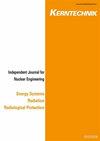辐射设施的有效物理防护系统设计和实施:综合风险管理方法
IF 0.4
4区 工程技术
Q4 NUCLEAR SCIENCE & TECHNOLOGY
引用次数: 0
摘要
每当发生针对核和放射性设施的盗窃或破坏行为时,生命就受到威胁,因此,物理保护系统有效地用于防止或减轻宝贵资产的损失。提供放射治疗服务的保健设施在其设施内设有一个临时储存单元,存放废弃的放射源60Co、137Cs和192Ir,这引起了对有效物理保护的关注。综合实物保护系统被认为是将与保护系统有关的所有分系统、传感器和要素整合在一起,以确保辐射设施的环境得到有效保护。序列对手图(ASD)是用来描述敌人实现破坏或偷窃目标的路径,并分析路径中的气流。这种安全系统有效性的方法侧重于使用概率统计方法进行风险评估,考虑到检测,延迟和响应。本文考虑了辐射中心物理防护体系所需的基本和有效要素,并将风险评估作为安全体系有效性的一种方法,为决策者建立有效的辐射中心物理防护体系提供了根本的指导原则。本文章由计算机程序翻译,如有差异,请以英文原文为准。
Effective physical protection system design and implementation at a radiological facility: an integrated and risk management approach
Abstract Lives are threatened whenever there is an act of theft or destruction against a nuclear and radiological facility thus, physical protection systems are effectively employed to prevent or mitigate loss of valuable assets. Health facilities that provide radiotherapy services have in their facility a temporary storage unit where disused radioactive sources 60Co, 137Cs and 192Ir are kept and this raises concerns for effective physical protection. An integrated physical protection System was considered to consolidate of all sub systems, sensors and elements related to protection system for an effectively secured environment at a radiological facility. Sequence adversary diagram (ASD) was developed to depict the paths that enemies can take to achieve sabotage or stealing objectives and analyze flews in the paths. The approach to this security system effectiveness focuses on using probabilistic statistical methods for risk evaluation considering detection, delays and response. This paper considers the basic and effective elements required for physical protection system for a radiological center and makes risk evaluation as an approach of security system effectiveness which can serve as fundamental guiding principle for decision makers in the establishment of an effective physical protection for a radiological center.
求助全文
通过发布文献求助,成功后即可免费获取论文全文。
去求助
来源期刊

Kerntechnik
工程技术-核科学技术
CiteScore
0.90
自引率
20.00%
发文量
72
审稿时长
6-12 weeks
期刊介绍:
Kerntechnik is an independent journal for nuclear engineering (including design, operation, safety and economics of nuclear power stations, research reactors and simulators), energy systems, radiation (ionizing radiation in industry, medicine and research) and radiological protection (biological effects of ionizing radiation, the system of protection for occupational, medical and public exposures, the assessment of doses, operational protection and safety programs, management of radioactive wastes, decommissioning and regulatory requirements).
 求助内容:
求助内容: 应助结果提醒方式:
应助结果提醒方式:


